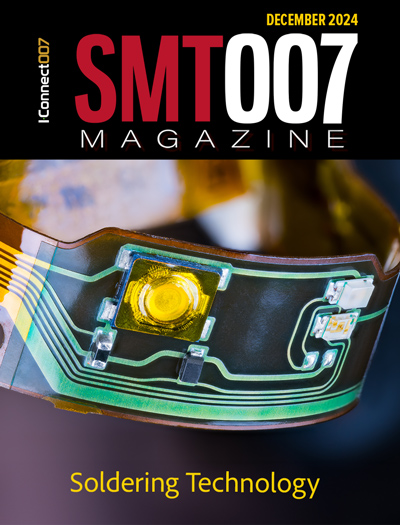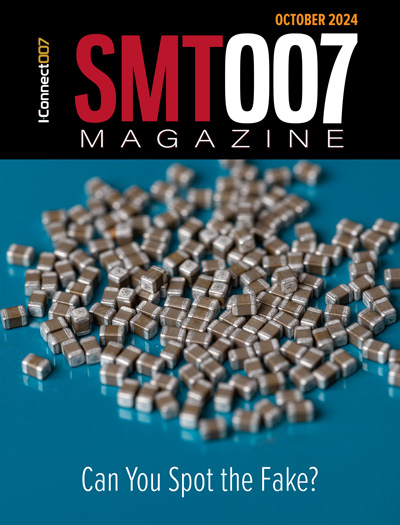-

- News
- Books
Featured Books
- smt007 Magazine
Latest Issues
Current Issue
Soldering Technologies
Soldering is the heartbeat of assembly, and new developments are taking place to match the rest of the innovation in electronics. There are tried-and-true technologies for soldering. But new challenges in packaging, materials, and sustainability may be putting this key step in flux.

The Rise of Data
Analytics is a given in this industry, but the threshold is changing. If you think you're too small to invest in analytics, you may need to reconsider. So how do you do analytics better? What are the new tools, and how do you get started?

Counterfeit Concerns
The distribution of counterfeit parts has become much more sophisticated in the past decade, and there's no reason to believe that trend is going to be stopping any time soon. What might crop up in the near future?
- Articles
- Columns
Search Console
- Links
- Media kit
||| MENU - smt007 Magazine
Machine Vision: MVTec Presents New and Optimized Features With Halcon 20.05
April 8, 2020 | MVTecEstimated reading time: 2 minutes
MVTec Software GmbH, the leading international provider of machine vision software, will launch a new Progress release of its standard software HALCON on May 20, 2020. HALCON 20.05 offers both entirely new features and updated technologies from the previous version, which can be used to further optimize machine vision processes. The bar code reader has been improved by an advanced decoding algorithm, which increases the decoding rate when reading codes with very thin bars. Thanks to this, it is now possible to even read codes with bars smaller than one pixel. With HALCON 20.05, training for all deep learning technologies can now be performed on a central processing unit (CPU). By removing the need for a dedicated graphics processing unit (GPU), standard industrial PCs that could not house powerful GPUs can now be used for training. Customers benefit from significantly greater flexibility regarding the implementation of deep learning, because training can now be performed directly on the production line.
Another new development is that the generic box finder released with the previous version has been improved in terms of robustness, performance, speed, and usability: With MVTec HALCON 20.05, it is now much easier to find boxes of different shapes and sizes reliably. In addition, the Grad-CAM-based heatmap (Gradient-weighted Class Activation Mapping) can now be calculated on the CPU without significant speed drops. This means that users are now able to analyze directly which parts of an image influence the deep learning network's classification decision. Moreover, the anomaly detection has been significantly improved in the current HALCON version. Training the network is now up to ten times faster, and inference speed has also been improved. Trained networks now also require less memory and disk space, which makes the feature more viable for use on embedded devices.
Surface-based 3D matching improved
Another new function improves processes in manufacturing, where workpieces must be located robustly and accurately to allow for further processing. Characteristics such as small holes are often the only unique features to find the correct orientation of the object. HALCON's surface-based 3D matching can now make use of such features to improve the accuracy and robustness of the matching results.
"More than ever before, MVTec HALCON 20.05 demonstrates the benefits that the short release cycle of our HALCON Progress Edition has to offer. In addition to the fast delivery of new features, we can also incorporate the latest customer feedback into the software product within a short period of time. This approach allows us to quickly optimize functionalities and thus make them even more attractive to our customers," explains Mario Bohnacker, Technical Product Manager HALCON at MVTec.
Suggested Items
CACI Chairman, Michael A. Daniels, Receives Prestigious Lifetime Achievement Recognition from NACD
12/20/2024 | CACI International Inc.CACI International Inc announced that CACI Chairman of the Board of Directors Michael (Mike) A. Daniels was presented with the prestigious 2024 National Association of Corporate Directors (NACD) Directorship 100™ B. Kenneth West Lifetime Achievement Award at its annual gala in New York.
The Right Approach: ‘Twas the Night Before Christmas (Harley-style)
12/23/2024 | Steve Williams -- Column: The Right ApproachAs we are in the middle of the holiday season with Christmas fast approaching, I thought it an appropriate time for a break from the typical technical topics and perhaps give everyone a chuckle. I wrote this a number of years back before Nancy and I sold our Harleys, but we never really left the lifestyle. Once a biker, always a biker.
PI's New Expansion for Higher Electronics Manufacturing Capacities and Shorter Lead Times
11/20/2024 | PRNewswirePI, the market and technology leader for high-precision motion control, positioning technology, and piezo applications, has completed the construction of additional electronics production space at its Rosenheim, Germany site.
SMTA: Capital Chapter & Connecticut Chapter Joint Technical Webinar
11/12/2024 | SMTAThe SMTA Capital Chapter is co-hosting a free webinar for SMTA members with the SMTA Connecticut Chapter on Tuesday, November 19 at 11:00 a.m. EST.
2024 Stromberg Student Leader Scholarship Recipient Announced
11/05/2024 | SMTASMTA is pleased to announce Waad Tarman, Auburn University, has been selected as the recipient of the 2024 JoAnn Stromberg Student Leader Scholarship.


